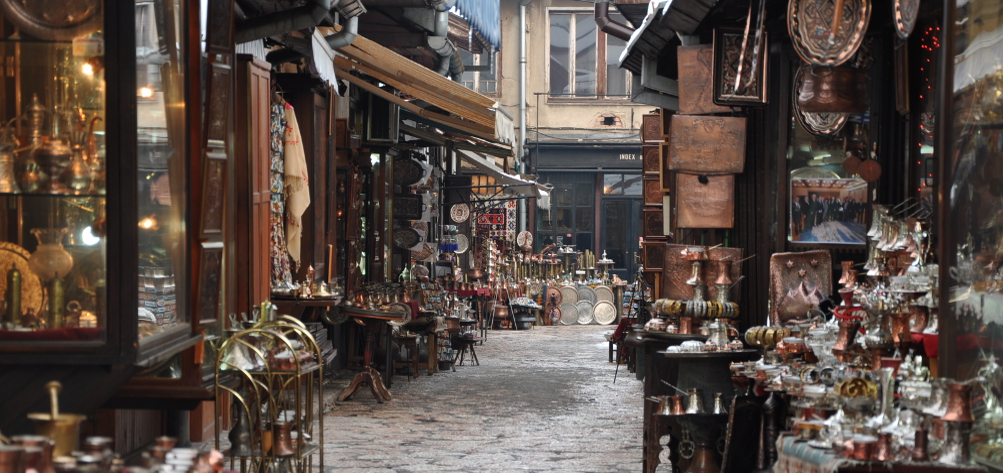Explore Sarajevo!

Baščaršija (pronounced [baʃ.tʃǎr.ʃi.ja]) is Sarajevo's old bazaar and the historical and cultural center of the city. Baščaršija was built in the 15th century when Isa-Beg Isaković founded the town.[1] The word Baščaršija derives from the Turkish language. The word "baš" which is "baş" in Turkish literally means "head", in some contexts however also "primary", "main", "capital" and "čaršija" which is "çarşı" in Turkish means "bazaar" or "market".[2] Due to the large fire in the 19th century....

The Gazi Husrev-bey Mosque (Bosnian: Gazi Husrev-begova Džamija, Turkish: Gazi Hüsrev Bey Camii), is a mosque in the city of Sarajevo, Bosnia and Herzegovina. Built in 16th century, it is the largest historical mosque in Bosnia and Herzegovina and one of the most representative Ottoman structures in the Balkans. Being the central Sarajevan mosque since the days of its construction, today it also serves as the main congregational mosque of the Islamic community. ....

The Sebilj (Bosnian: sebilj - Turkish: sebil) is a kiosk-shaped public wooden and stone fountain. The Sebilj is a pseudo-Ottoman-style wooden fountain (Sebil) in the centre of Baščaršija square in Sarajevo built by Mehmed Pasha Kukavica in 1753. It was relocated by Austrian architect Alexander Wittek in 1891. It is also frequently called "the pigeon square"...

The Sarajevo Haggadah is an illuminated manuscript that contains the illustrated traditional text of the Passover Haggadah which accompanies the Passover Seder. It is one of the oldest Sephardic Haggadahs in the world, originating in Barcelona around 1350. The Haggadah is owned by the National Museum of Bosnia and Herzegovina in Sarajevo. Its monetary value is undetermined, but a museum in Spain required that it be insured for $7 million before it could be transported to an exhibition there in 1992.The Sarajevo Haggadah is handwritten on bleached calfskin and illuminated in copper and gold...

Vrelo Bosne (pronounced [ʋrê.lo bôs.neː]; English: Spring of the Bosna River) is the spring of the River Bosna located in Sarajevo, Bosnia and Herzegovina. It is one of the country's top natural landmarks and is one of the most famous scenes of natural beauty in the region. The park is usually entered by foot or, for a reasonable price, by horse-carriage via the main avenue leading into it.The avenue itself contains traditional buildings from the Austro-Hungarian-era offering a peek into the luxuries of the past....

he Sacred Heart Cathedral (Bosnian: Katedrala Srca Isusova) in Sarajevo, commonly referred as the Sarajevo Cathedral is the largest cathedral in Bosnia and Herzegovina. It is the seat of the Archbishop of Vrhbosna, currently Cardinal Vinko Puljić, and center of Catholic worship in the city.he Cathedral is located in the city's Old Town district Sacred Heart Cathedral was built in honor of the Sacred Heart of Jesus, an important Catholic concept...

This house has entered into history and became one of the legends of Sarajevo during the rule of Austria-Hungary monarchy. At the end of 20 century new rulers started building City Hall it suposed to be demolished, but the owner was against that and house was moved to the other side of the river in its original form. Brick by brick, stone by stone. Its locate just oposite of City Hall (the most famous buildings in Sarajevo), on the other end of Šeher – Ćehajas bridge. More on this story can be found in the part of history.. .

Historical Museum of Bosnia and Herzegovina was founded on 13. November 1945. by the law on founding of Museum of national Liberation in Sarajevo. The initiative to establish Museum was undertaken by decree of Presidency of People Assembly of Bosnia and Herzegovina. At that time, Museum was situated in National library in Town Hall (Vijeanica). Since 1963. Museum is situated in building specially built for such purpose. Museum changed its name several times and cronologically expanded the borders of its researching and collecting work towards past and present....
